Novel Wear-Resistant Mechanism Induced by MUPZs via RRA Process in Microalloyed High Manganese Steel
Abstract
1. Introduction
2. Materials and Methods
3. Results and Discussion
3.1. Microstructure Characterization
3.2. Mechanical Properties
3.3. Impact Abrasive Wear Sub-Surface Characterization
3.4. Impact Abrasive Wear Properties and Wear-Resistant Mechanism
4. Conclusions
- (1)
- Through the complete RRA treatment, the retrogression process can be used to dissolve the aggregated sub-micron precipitates formed at the edges of the initial micron precipitates during the pre-aging stage, and alloying elements such as V and Nb can diffuse a certain distance. Then, in the short-term re-aging process, the (Nb, V)x (C, N)y are dispersed again at the sub-micron and nanoscales, and form the micro-scale ultrafine precipitation zones (MUPZs);
- (2)
- Through the complete RRA treatment, the specimen can be given good mechanical properties with a yield strength of 490 MPa, tensile strength of 965 MPa, elongation of 40.0%, and micro-Vickers hardness of nearly 322 HV;
- (3)
- The specimens after different stage of the RRA process (pre-aging, retrogression, re-aging) are compared under a 5 h impact abrasive wear test with a 5 J impact load. The subsurface characterization shows that MUPZs can play a significant role in resisting the abrasive and decreasing the wear loss caused by micro-cutting and micro-plowing mechanism;
- (4)
- The RRA specimens with MUPZs were compared after 5 h of impact abrasive wear tests under 2.5 J and 5 J energies. It was demonstrated that MUPZs exhibit better work-hardening and wear-resistant abilities. Additionally, an adhesive layer composed of broken abrasive particles can be formed near the wear surface with MUPZs. This layer resists abrasive particles and causes them to bounce off, presenting a novel impact abrasive wear-resistant mechanism.
Author Contributions
Funding
Data Availability Statement
Acknowledgments
Conflicts of Interest
References
- Bambach, M.; Conrads, L.; Daamen, M.; Güvenç, O.; Hirt, G. Enhancing the crashworthiness of high-manganese steel by strain-hardening engineering, and tailored folding by local heat-treatment. Mater. Des. 2016, 110, 157–168. [Google Scholar] [CrossRef]
- Kuyucak, S.; Zavadil, R.; Gertsman, V. Heat-treatment processing of austenitic manganese steels. Rev. Turnat. (Rom. Foundry J.) 2004, 10, 11–14. [Google Scholar]
- Xu, H.; Zhao, J.; Cao, W.; Shi, J.; Wang, C.; Wang, C.; Li, J.; Dong, H. Heat treatment effects on the microstructure and mechanical properties of a medium manganese steel (0.2 C–5Mn). Mater. Sci. Eng. A 2012, 532, 435–442. [Google Scholar] [CrossRef]
- Smith, R.; DeMonte, A.; Mackay, W. RETRACTED: Development of high-manganese steels for heavy duty cast-to-shape applications. J. Mater. Process. Technol. 2004, 153–154, 589–595. [Google Scholar] [CrossRef]
- Haase, C.; Kühbach, M.; Barrales-Mora, L.A.; Wong, S.L.; Roters, F.; Molodov, D.A.; Gottstein, G. Recrystallization behavior of a high-manganese steel: Experiments and simulations. Acta Mater. 2015, 100, 155–168. [Google Scholar] [CrossRef]
- Tęcza, G.; Garbacz-Klempka, A. Microstructure of cast high-manganese steel containing titanium. Arch. Foundry Eng. 2016, 16, 163–168. [Google Scholar] [CrossRef]
- Pham, M.K.; Nguyen, D.N.; Hoang, A.T. Influence of vanadium content on the microstructure and mechanical properties of high-manganese steel. Int. J. Mech. Mechatron. Eng. 2018, 18, 141–147. [Google Scholar]
- Morrison, W. Microalloy steels–the beginning. Mater. Sci. Technol. 2009, 25, 1066–1073. [Google Scholar] [CrossRef]
- Siciliano, F.; Jonas, J.J. Mathematical modeling of the hot strip rolling of microalloyed Nb, multiply-alloyed Cr-Mo, and plain C-Mn steels. Metall. Mater. Trans. A 2000, 31, 511–530. [Google Scholar] [CrossRef]
- Moghaddam, E.; Varahram, N.; Davami, P. On the comparison of microstructural characteristics and mechanical properties of high-vanadium austenitic manganese steels with the Hadfield steel. Mater. Sci. Eng. A 2012, 532, 260–266. [Google Scholar] [CrossRef]
- Di, X.; Li, M.; Yang, Z.; Wang, B.; Guo, X. Microstructural evolution, coarsening behavior of vanadium carbide and mechanical properties in the simulated heat-affected zone of modified medium manganese steel. Mater. Des. 2016, 96, 232–240. [Google Scholar] [CrossRef]
- Ren, J.-k.; Chen, Q.-y.; Chen, J.; Liu, Z.-y. Role of vanadium additions on tensile and cryogenic-temperature charpy impact properties in hot-rolled high-Mn austenitic steels. Mater. Sci. Eng. A 2021, 811, 141063. [Google Scholar] [CrossRef]
- Cai, Z.; Wang, S.; Zhou, Y.; Dong, J.; Ma, L.; Liu, S. Influence of aging treatment on mechanical properties and wear resistance of medium manganese steel reinforced with Ti (C, N) particles. Friction 2023, 1–14. [Google Scholar] [CrossRef]
- Jacob, R.; Sankaranarayanan, S.R.; Babu, S.K. Recent advancements in manganese steels—A review. Mater. Today Proc. 2020, 27, 2852–2858. [Google Scholar] [CrossRef]
- Bouaziz, O.; Allain, S.; Scott, C.; Cugy, P.; Barbier, D. High manganese austenitic twinning induced plasticity steels: A review of the microstructure properties relationships. Curr. Opin. Solid State Mater. Sci. 2011, 15, 141–168. [Google Scholar] [CrossRef]
- Kim, J.G.; Enikeev, N.A.; Seol, J.B.; Abramova, M.M.; Karavaeva, M.V.; Valiev, R.Z.; Park, C.G.; Kim, H.S. Superior strength and multiple strengthening mechanisms in nanocrystalline TWIP steel. Sci. Rep. 2018, 8, 11200. [Google Scholar] [CrossRef]
- Wen, Y.H.; Peng, H.; Si, H.; Xiong, R.; Raabe, D. A novel high manganese austenitic steel with higher work hardening capacity and much lower impact deformation than Hadfield manganese steel. Mater. Des. 2014, 55, 798–804. [Google Scholar] [CrossRef]
- Agunsoye, J.O.; Talabi, S.I.; Bello, O. Wear characteristics of heat-treated Hadfield austenitic manganese steel for engineering application. Adv. Prod. Eng. Manag. 2015, 10, 97–107. [Google Scholar] [CrossRef]
- Zhou, Z.; Shan, Q.; Jiang, Y.; Li, Z.; Zhang, Z. Effect of nanoscale V2C precipitates on the three-body abrasive wear behavior of high-Mn austenitic steel. Wear 2019, 436, 203009. [Google Scholar] [CrossRef]
- Li, C.; Li, X.; Deng, X.; Wang, Z. Revealing the role of micron-sized in situ TiC particles on tensile properties and fracture mechanism of martensitic wear-resistant steel at elevated temperature. Mater. Sci. Eng. A 2022, 832, 142503. [Google Scholar] [CrossRef]
- Zhong, H.; Li, S.; Wu, J.; Deng, H.; Chen, J.; Yan, N.; Chen, Z.; Duan, L. Effects of retrogression and re-aging treatment on precipitation behavior, mechanical and corrosion properties of a Zr + Er modified Al-Zn-Mg-Cu alloy. Mater. Charact. 2022, 183, 111617. [Google Scholar] [CrossRef]
- Altuntaş, G.; Altuntaş, O.; Bostan, B. Characterization of Al-7075/T651 Alloy by RRA Heat Treatment and Different Pre-deformation Effects. Trans. Indian Inst. Met. 2021, 74, 3025–3033. [Google Scholar] [CrossRef]
- Liu, P.; Hu, L.; Zhang, Q.; Yang, C.; Yu, Z.; Zhang, J.; Hu, J.; Cao, F. Effect of aging treatment on microstructure and corrosion behavior of Al-Zn-Mg aluminum alloy in aqueous solutions with different aggressive ions. J. Mater. Sci. Technol. 2021, 64, 85–98. [Google Scholar] [CrossRef]
- Li, B.; Wang, X.; Chen, H.; Hu, J.; Huang, C.; Gou, G. Influence of heat treatment on the strength and fracture toughness of 7N01 aluminum alloy. J. Alloys Compd. 2016, 678, 160–166. [Google Scholar] [CrossRef]
- Haider, T.N.; Kahtan, S.M. Microstructural evaluation and mechanical properties of an Al-Zn-Mg-Cu-alloy after addition of nickel under RRA conditions. Mater. Sci. Appl. 2013, 2013, 39744. [Google Scholar]
- Sun, T.; Liang, J.; Li, D.; Zhong, L.; Gong, C. A New Detection Method for Oxygen, Nitrogen and Hydrogen on Superalloy Milling Surfaces. Int. J. Mech. Eng. Appl. 2018, 6, 29–34. [Google Scholar] [CrossRef]
- Cheng, C.; Dou, Z.-H.; Zhang, T.-A.; Su, J.-M.; Zhang, H.-J.; Liu, Y.; Niu, L.-P. Sulfur distribution in preparation of high titanium ferroalloy by thermite method with different CaO additions. Rare Met. 2019, 38, 793–799. [Google Scholar] [CrossRef]
- Kuzucu, V.; Aksoy, M.; Korkut, M.; Yildirim, M. The effect of niobium on the microstructure of ferritic stainless steel. Mater. Sci. Eng. A 1997, 230, 75–80. [Google Scholar] [CrossRef]
- Luo, W.; Wang, L.; Wang, Y.; Meng, L.; Yuan, Y.; Zhang, L.; Wu, G. Microstructure and mechanical properties of a 2 wt% Nb bearing low carbon steel. Mater. Sci. Eng. A 2021, 826, 141957. [Google Scholar] [CrossRef]
- Chateau, J.; Dumay, A.; Allain, S.; Jacques, A. Precipitation hardening of a FeMnC TWIP steel by vanadium carbides. J. Phys. Conf. Ser. 2010, 240, 012023. [Google Scholar] [CrossRef]
- Klinkenberg, C.; Hulka, K.; Bleck, W. Niobium carbide precipitation in microalloyed steel. Steel Res. Int. 2004, 75, 744–752. [Google Scholar] [CrossRef]
- Zhang, S.; Chen, W.; Huang, F.; Cheng, Y.F.; Li, K.; Hu, Q.; Liu, J. The significant effect of tantalum on the hydrogen-induced cracking of pipeline steel: Morphology, hydrogen permeation, and theoretical studies. Corros. Sci. 2022, 200, 110213. [Google Scholar] [CrossRef]
- Chen, L.; Huang, X.; He, K.; Wang, H. Precipitation behavior and age hardening effect of the precipitates in a Fe-13Cr-4Al-2Mo-1.2 Nb alloy. Mater. Charact. 2021, 173, 110918. [Google Scholar] [CrossRef]
- Hussein, A.M.; Rao, S.I.; Uchic, M.D.; Dimiduk, D.M.; El-Awady, J.A. Microstructurally based cross-slip mechanisms and their effects on dislocation microstructure evolution in fcc crystals. Acta Mater. 2015, 85, 180–190. [Google Scholar] [CrossRef]
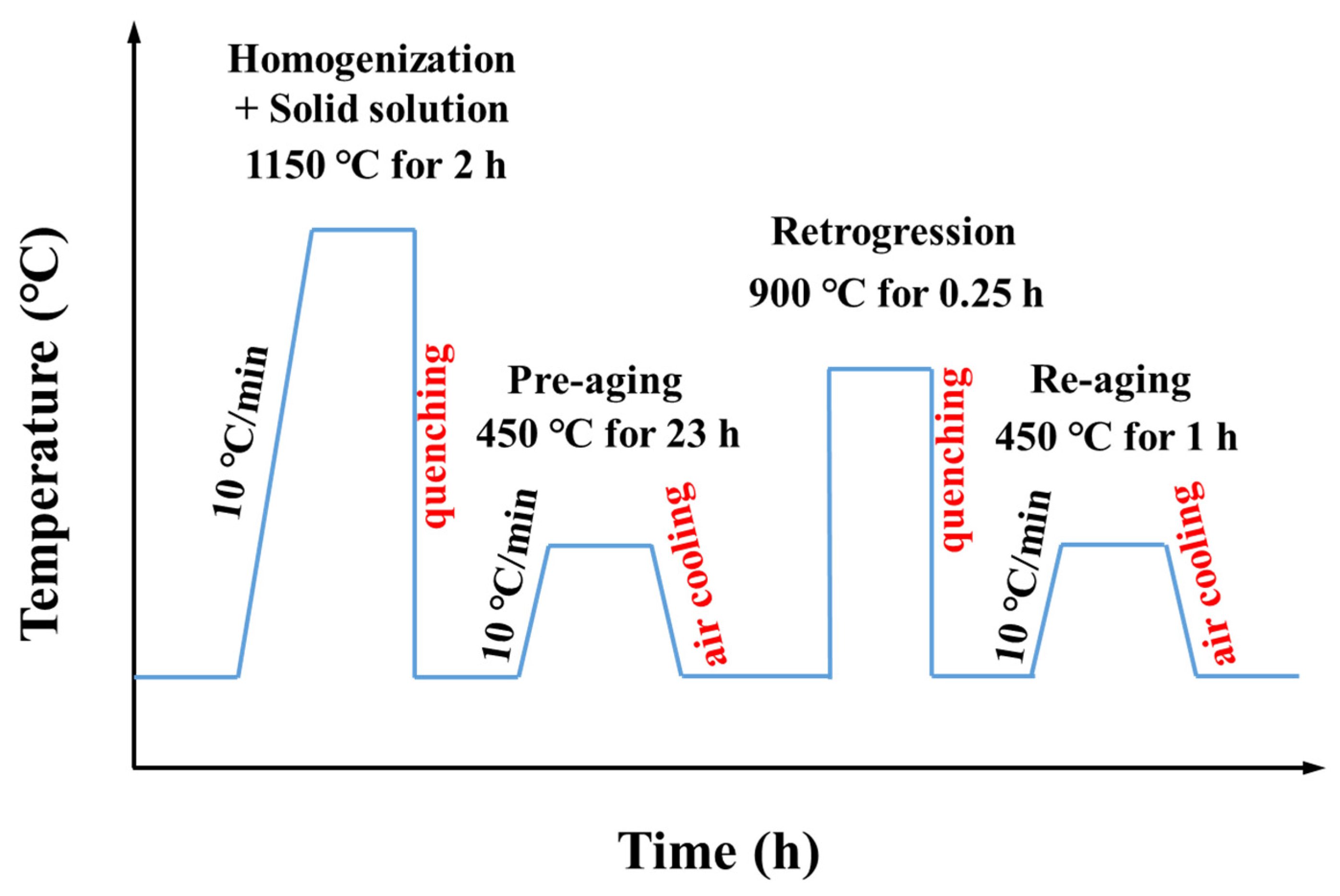
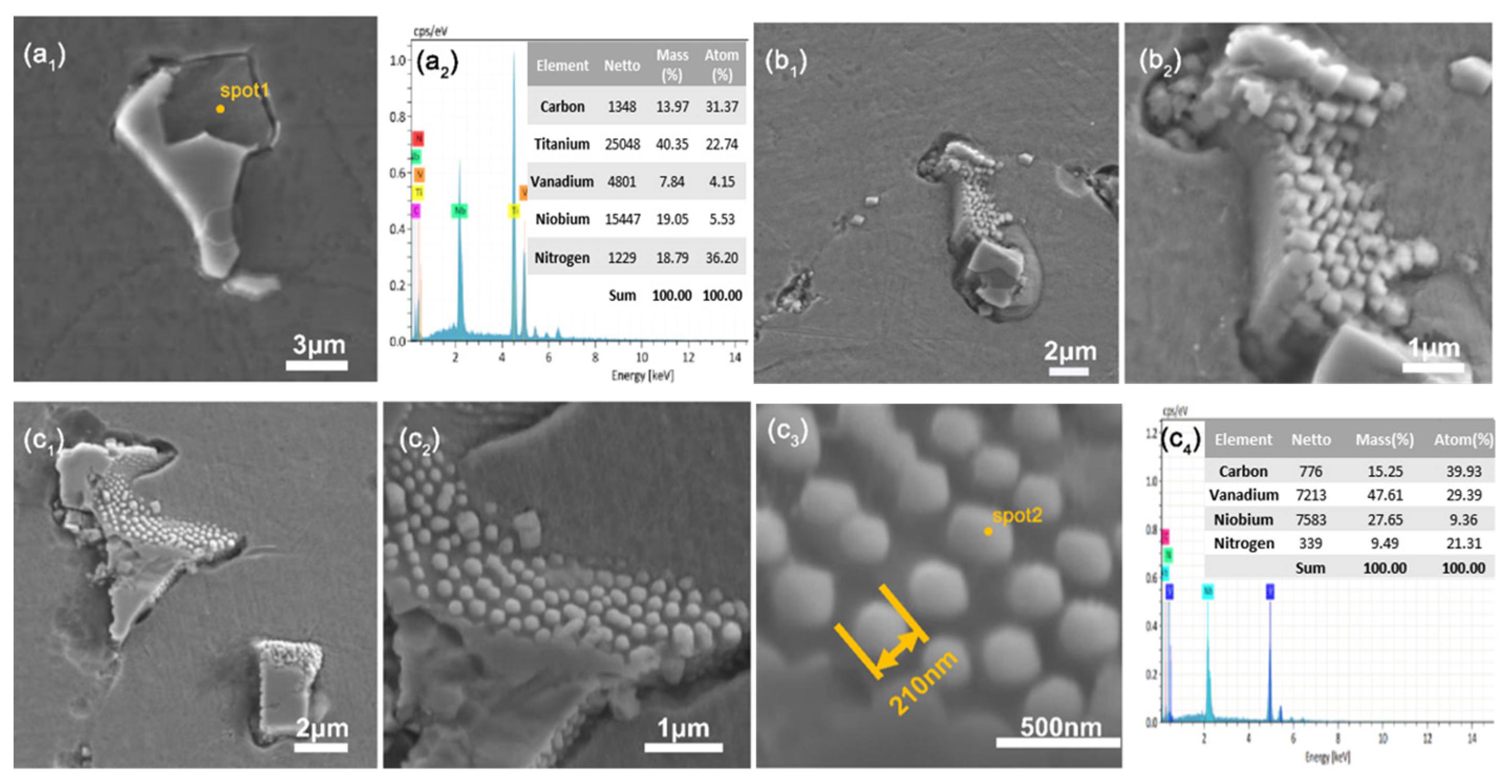
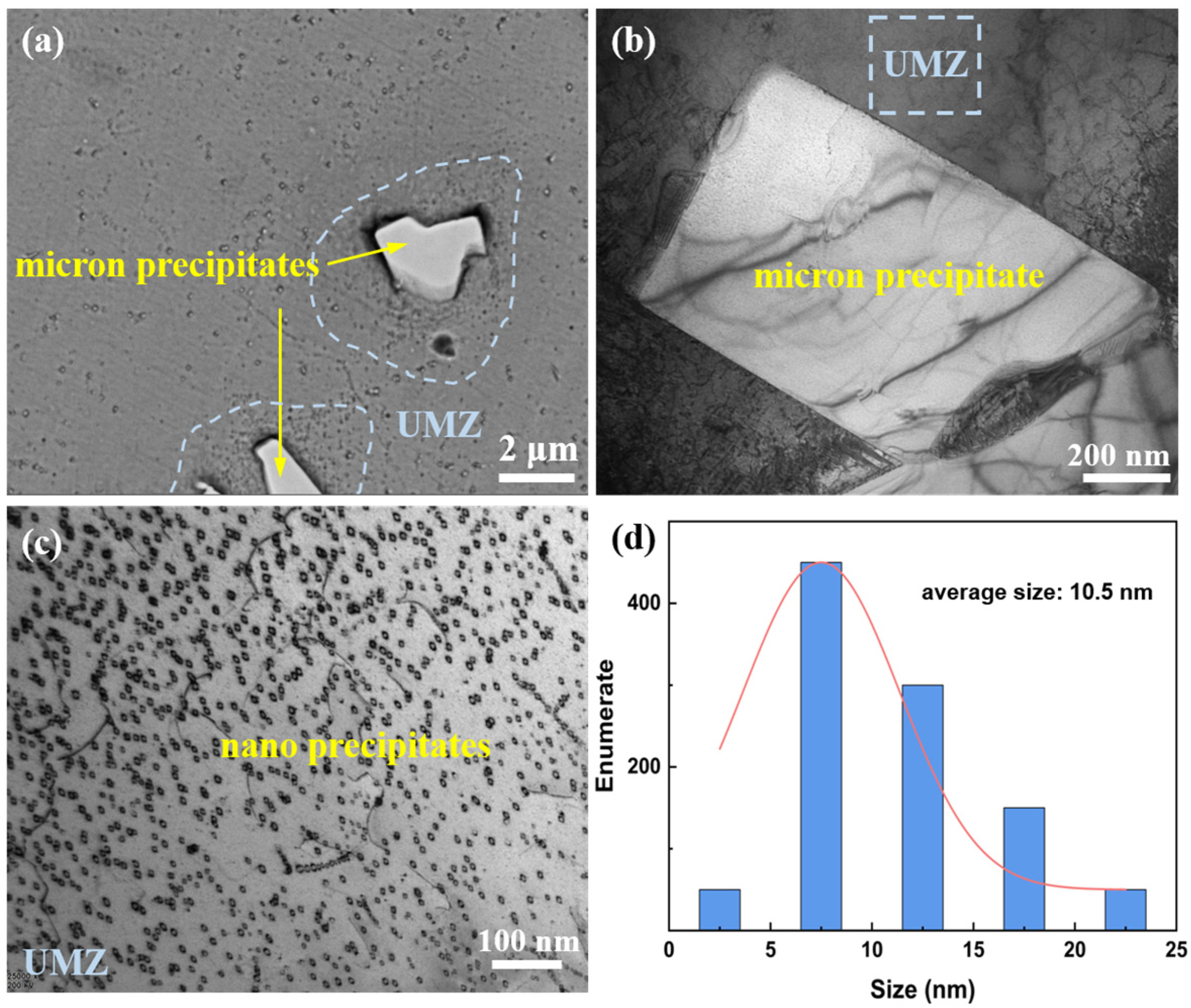
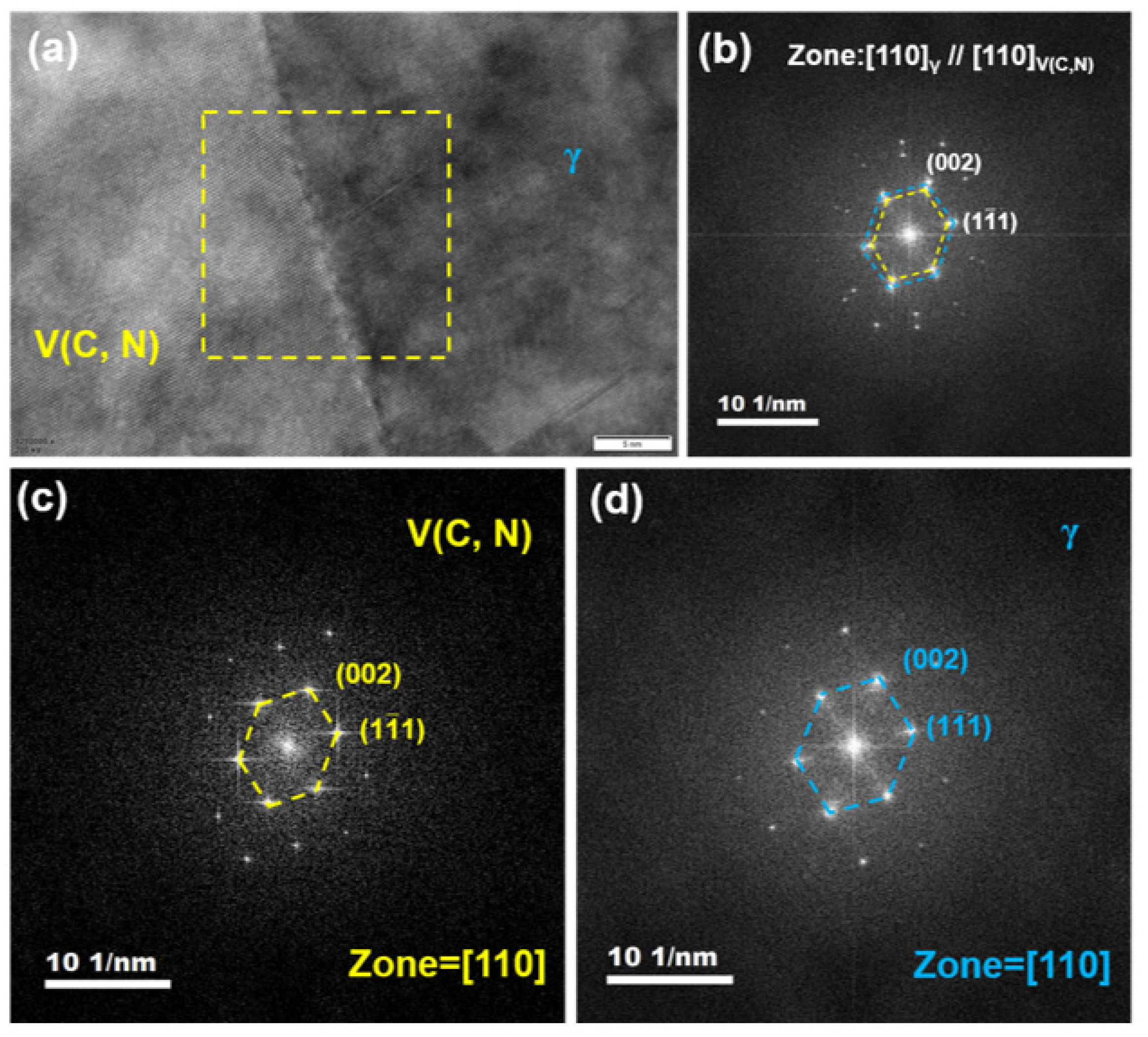


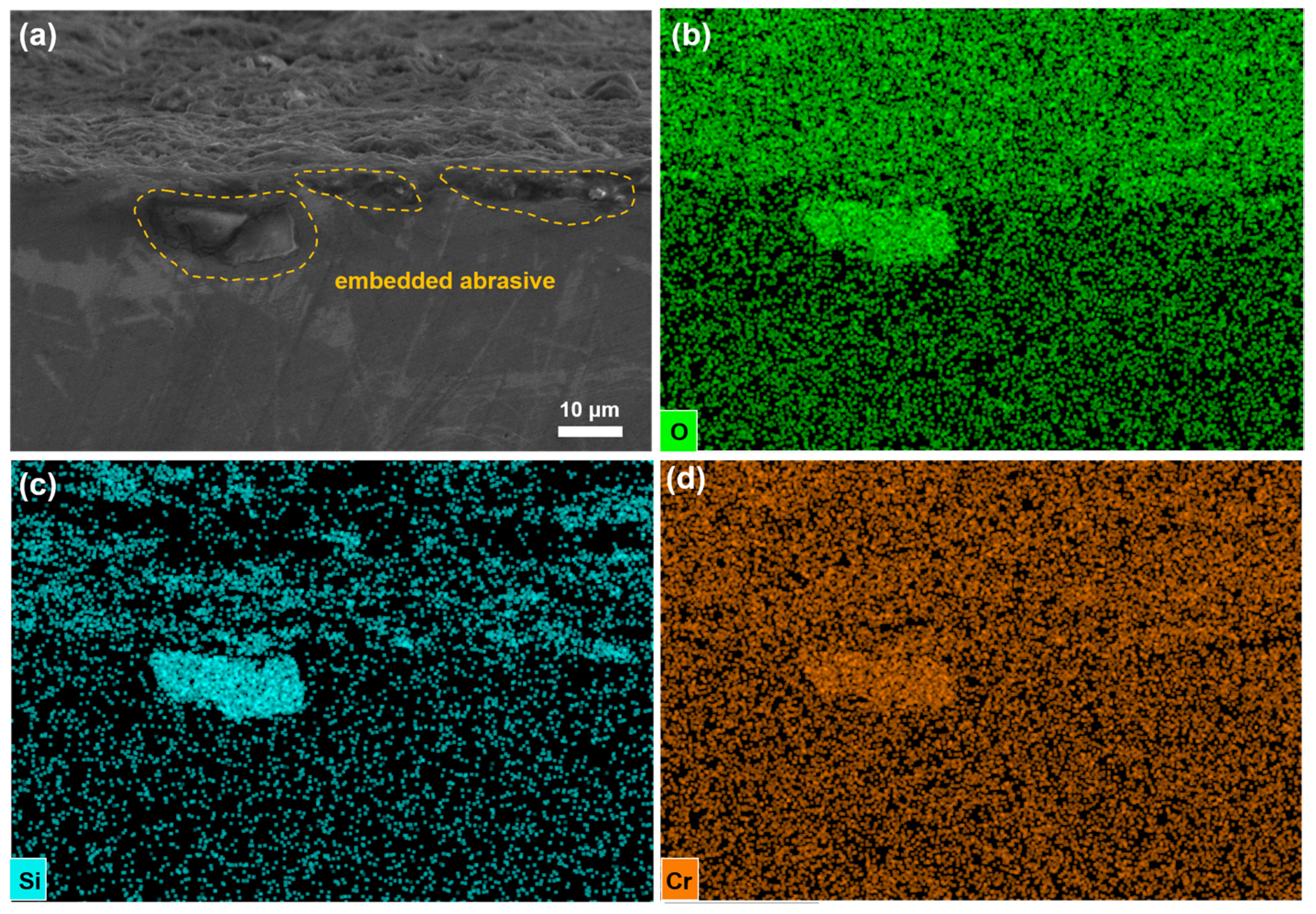
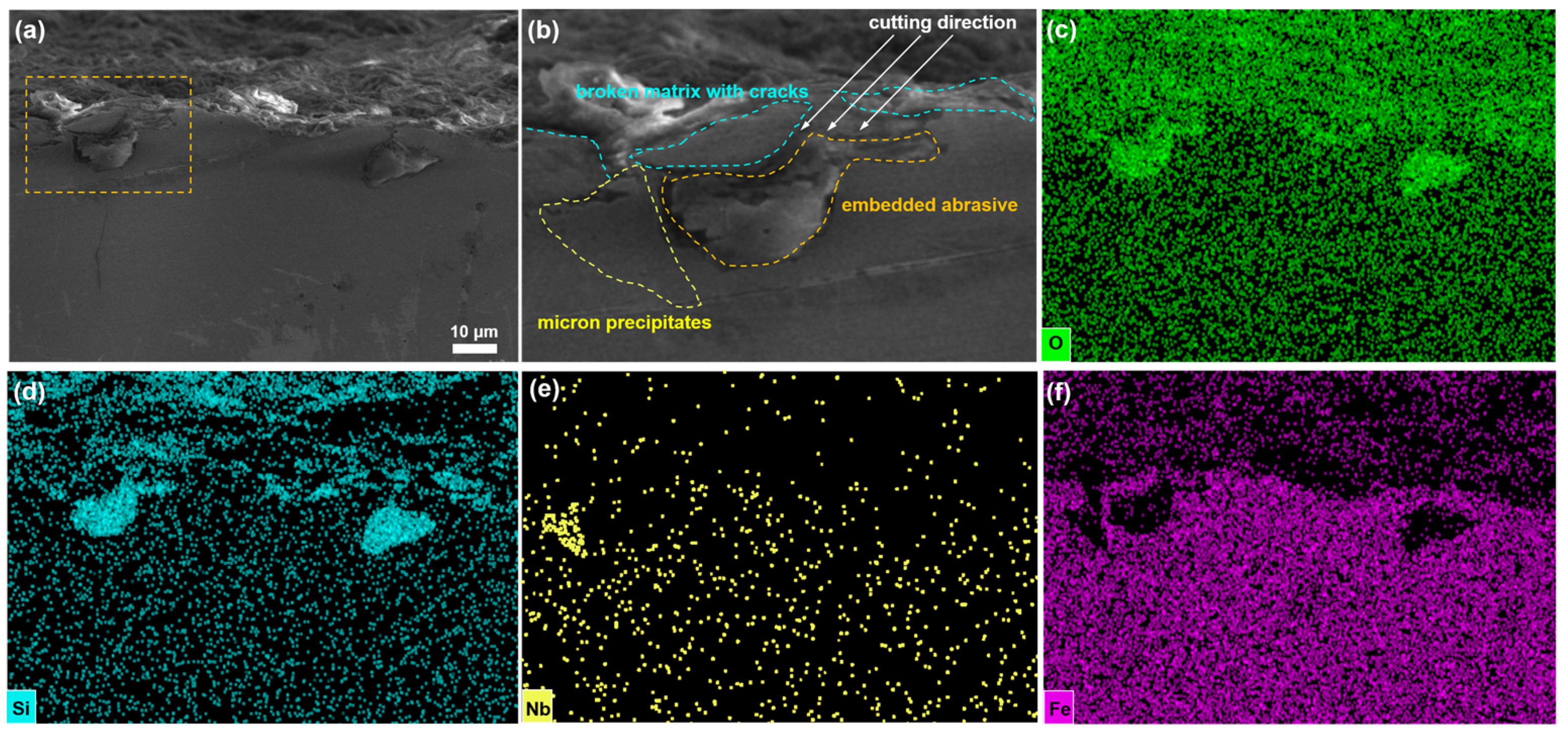

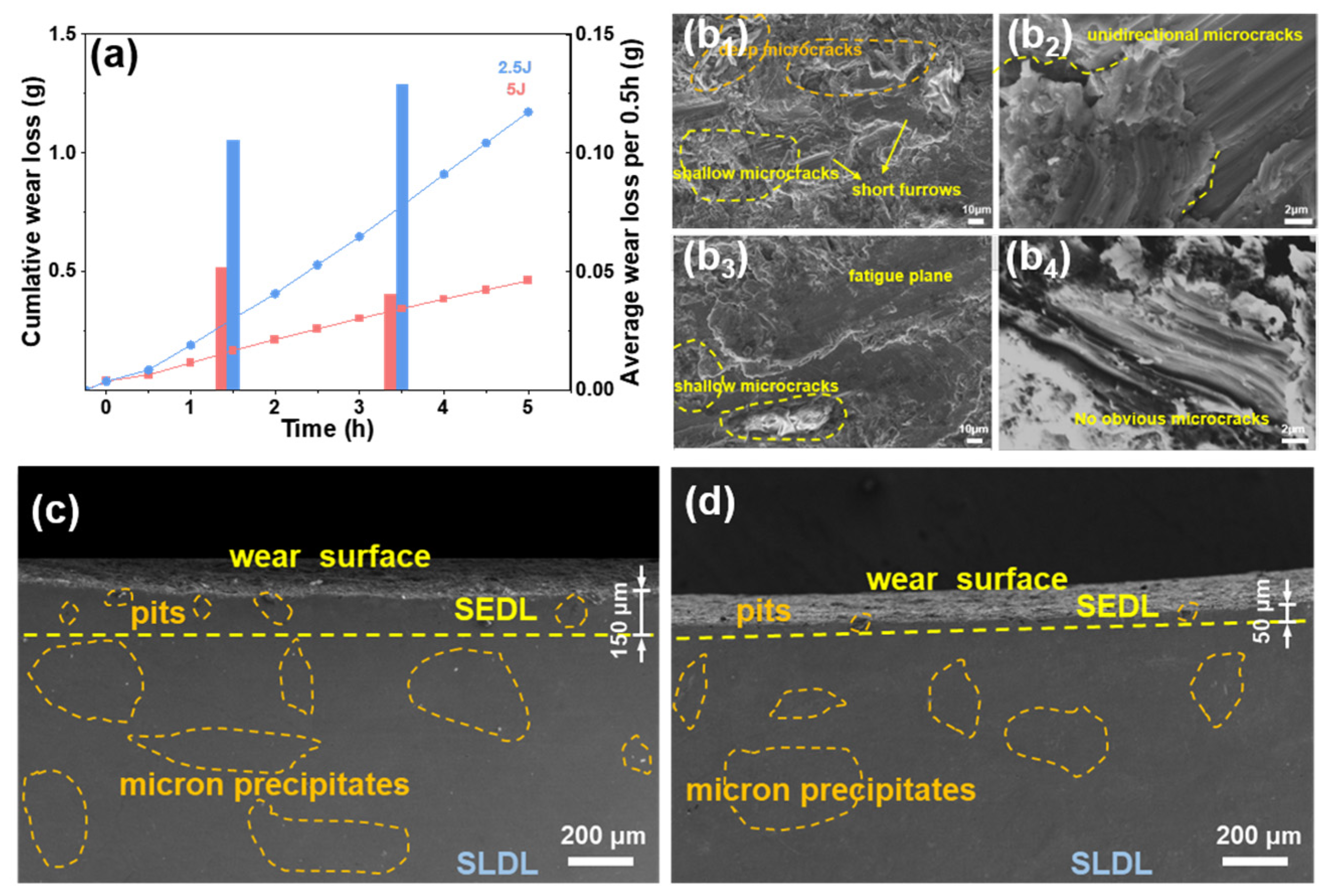
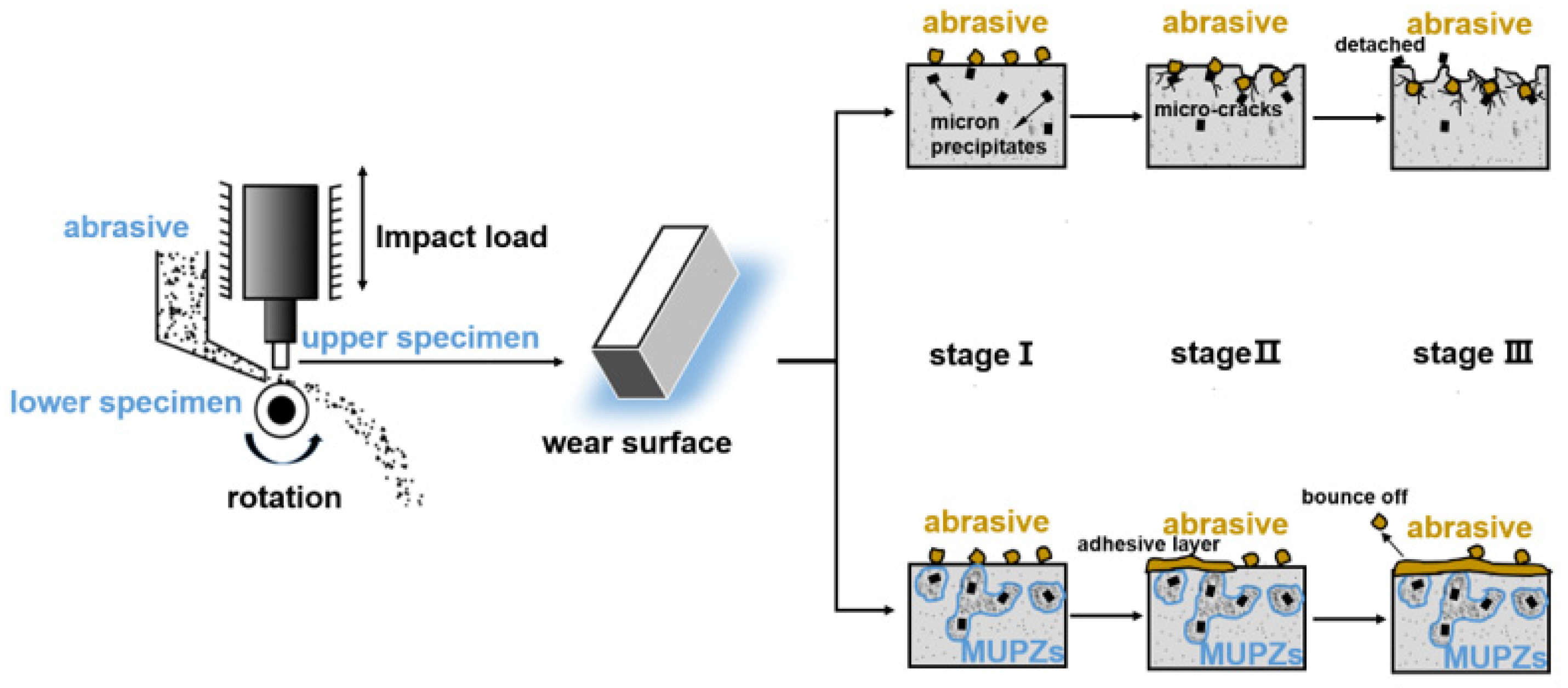
| C | Mn | Cr | Si | Ti | V | Nb | Cu | Ni | Mo | P | S | N |
|---|---|---|---|---|---|---|---|---|---|---|---|---|
| 0.92 | 18.80 | 1.87 | 0.88 | 0.10 | 0.36 | 0.11 | 0.46 | 0.22 | 0.41 | 0.005 | 0.01 | 0.090 |
Disclaimer/Publisher’s Note: The statements, opinions and data contained in all publications are solely those of the individual author(s) and contributor(s) and not of MDPI and/or the editor(s). MDPI and/or the editor(s) disclaim responsibility for any injury to people or property resulting from any ideas, methods, instructions or products referred to in the content. |
© 2023 by the authors. Licensee MDPI, Basel, Switzerland. This article is an open access article distributed under the terms and conditions of the Creative Commons Attribution (CC BY) license (https://creativecommons.org/licenses/by/4.0/).
Share and Cite
Wang, R.; Huang, X.; Zhang, W.; Fu, H.; Chen, X.; Li, Z.; Shan, Q. Novel Wear-Resistant Mechanism Induced by MUPZs via RRA Process in Microalloyed High Manganese Steel. Metals 2023, 13, 902. https://doi.org/10.3390/met13050902
Wang R, Huang X, Zhang W, Fu H, Chen X, Li Z, Shan Q. Novel Wear-Resistant Mechanism Induced by MUPZs via RRA Process in Microalloyed High Manganese Steel. Metals. 2023; 13(5):902. https://doi.org/10.3390/met13050902
Chicago/Turabian StyleWang, Rui, Xiaomin Huang, Wen Zhang, Hao Fu, Xin Chen, Zulai Li, and Quan Shan. 2023. "Novel Wear-Resistant Mechanism Induced by MUPZs via RRA Process in Microalloyed High Manganese Steel" Metals 13, no. 5: 902. https://doi.org/10.3390/met13050902
APA StyleWang, R., Huang, X., Zhang, W., Fu, H., Chen, X., Li, Z., & Shan, Q. (2023). Novel Wear-Resistant Mechanism Induced by MUPZs via RRA Process in Microalloyed High Manganese Steel. Metals, 13(5), 902. https://doi.org/10.3390/met13050902






